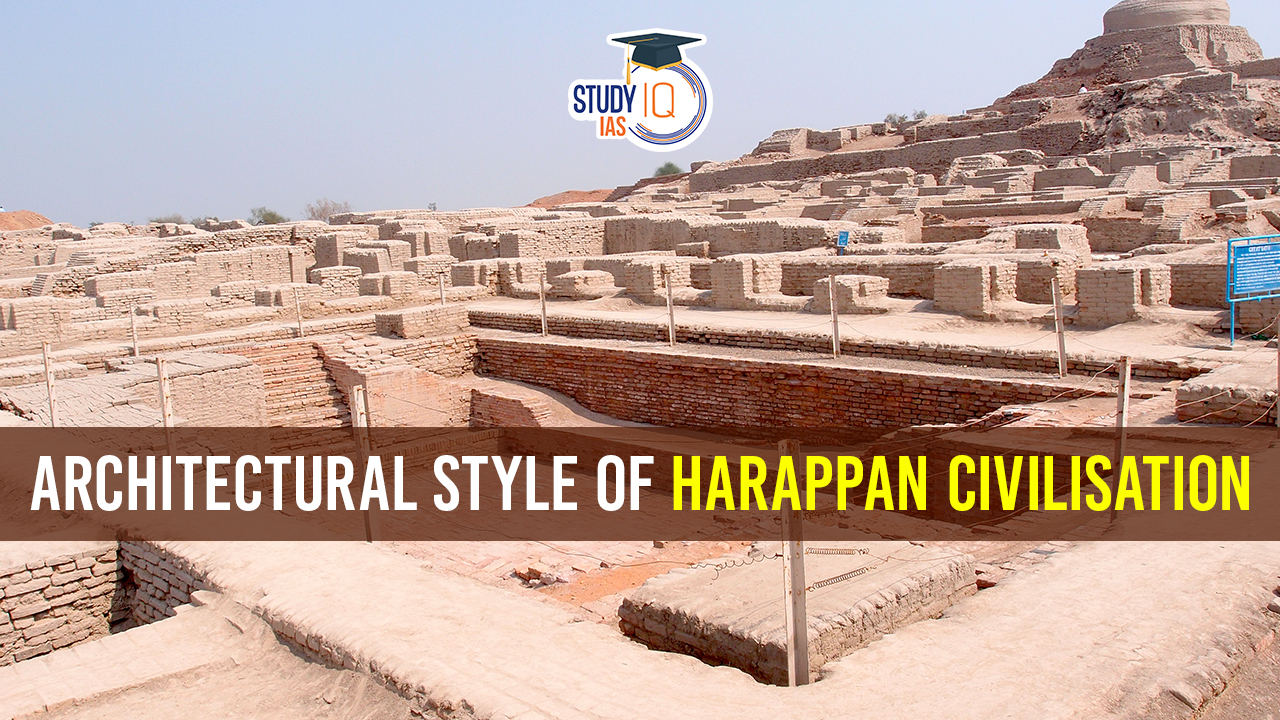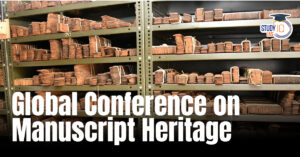Table of Contents
The Harappan Civilization, South Asia’s pioneering urban society in the Bronze Age, showcased advanced architectural prowess. Notable features include grid-patterned streets, standardized kiln-fired bricks, two-tiered city structures with citadels and lower towns, and iconic structures like the Great Bath. Harappan homes were often two-storied with central courtyards, and a sophisticated drainage system demonstrated their engineering acumen. Despite the mystery surrounding their script, remnants of Harappan architecture stand as a testament to a highly developed and enigmatic ancient civilization.
We’re now on WhatsApp. Click to Join
Harappan architecture
The Harappan civilization, thriving from around 3300 BCE to 1300 BCE in the Indus Valley, exhibited advanced urban planning and distinctive architecture. Notable for baked brick houses, intricate drainage and water supply systems, and large non-residential structures, cities like Mohenjo-daro and Harappa boasted populations ranging from 30,000 to 60,000. Integrated into international trade along the Indus River, the Harappan culture emerged as a complex amalgamation of diverse ethnic and linguistic groups.
By 2500 BCE, during the Mature Harappan phase, its urbanization marked a socio-cultural complexity, connecting with Mesopotamia and contributing to advancements in writing, long-distance trade, and cross-cultural influences, shaping the civilization’s unique architectural and town planning characteristics.
Features of Harappan Architecture
The architectural legacy of the Harappan Civilization stands as a testament to its uniqueness, devoid of foreign influences. Driven primarily by utilitarian purposes rather than ornamental considerations, the evolution of this architecture unfolded in isolation, shaped by local cultures and the experiences of the first farming and pastoralist settlements. The mature elegance of Harappan architecture sets it apart, showcasing a level of complexity and style unparalleled by other civilizations.
Town Planning in Harappan Civilization
Utilitarian Approach:
- Harappan architecture prioritized utility over aesthetic appeal.
- Introduction of separate worker’s quarters showcased a pragmatic perspective.
Diverse City Designs:
- Although cities had varied designs, a common pattern emerged.
- Structures included defensive walls, citadels, lower towns, alleys, roadways, and sophisticated drainage systems.
Geometric City Planning:
- City plans created using geometrical tools, with citadels often located in the west or south of lower towns.
- Cardinal directions used for partitioning rural villages into blocks, with residences lining streets.
| Aspect of Town Planning | Description |
| Grid Pattern | Cities designed on a meticulous grid pattern with streets running in north-south and east-west directions. |
| Streets and Lanes | Streets and lanes intersecting at right angles, dividing the city into rectangular blocks. |
| Fortification | Cities surrounded by fortified walls made of mud bricks for protection against various threats. |
| Division of Cities | Division into an elevated citadel (west) and lower town, with citadel housing large structures and lower town for common residences. |
| Material Usage | Extensive use of burnt bricks in a standardized size (1:2:4 ratio), absence of stone buildings. |
| Residential Areas | Distinct residential areas featuring baked brick houses, some multi-storied, surrounding courtyards. |
| Drainage Systems | Elaborate drainage systems with drains in every house connected to street drains. |
| Granaries and Storage | Well-planned granaries near citadel with thick walls to protect stored food; strategic locations for storage facilities. |
| Water Management | Adept management of water resources with well-built wells, reservoirs, and water tanks. |
| Commercial Areas | Presence of commercial areas with specialized workshops and shops, reflecting a well-organized economic system. |
| Uniform Town Planning | Notable uniformity across cities, indicating a centralized authority or shared urban planning system. |
Harappan Urban Layout and Features
Grid Pattern:
- Cities like Harappa and Mohenjodaro laid out in a grid pattern.
- Well-organized drainage systems aligned from east to west.
Acropolis and Lower Cities:
- Cities divided into fortified acropolis (citadel) and lower town.
- Acropolis housed important buildings like assembly halls, religious structures, granaries, and the Great Bath.
Straight Streets and Alleys:
- Streets and roadways were straight, intersecting at right angles.
- Grid layout divided the city into rectangular blocks with evidence of trash disposal.
Public Buildings in Harappan Civilization
Great Bath:
- Notable feature of Mohenjodaro, a large rectangular tank for ceremonial bathing.
- Includes galleries, chambers, stairs, and a sophisticated drainage system.
Granaries:
- Large structures facilitating prosperity; protected grains during crises.
- Examples in Mohenjodaro and Harappa showcase significant storage capacity.
Lothal Dockyard:
- Identified as a tidal dock; evidence of extensive trade with other civilizations.
- Connected Harappan cities to ancient courses of rivers for trade.
Harappan Drainage System and Sanitation
Efficient Drainage:
- Detailed knowledge of hydraulic engineering led to efficient drainage systems.
- Regularly spaced drops and self-cleaning drains ensured proper waste disposal.
Houses and Sanitation:
- Dwellings of various sizes with central courtyards, wells, and bathing places.
- Efficient drainage systems connected to well-designed structures.
Fortification Wall:
- Defended important Early Harappan towns; examples in Rehman Dehri, Tarakai Qila, Kohtras, etc.
- Served defensive purposes for protection and strength.
Gateways:
- Cities had one or more gateways; some plain, some with unique significance.
- Varied design elements showcased the diversity of Harappan urban planning.
Materials Used
Building Materials:
- Primary materials included sun-dried and burnt bricks in standardized ratios.
- Abundance of easily available wood for burning facilitated the creation of baked bricks.
Wells and Sanitation:
- Well-constructed wells and underground drains disposed of sewage efficiently.
- Sophisticated water management systems included reservoirs and drainage connected to homes.
Sculptures of Harappan Civilisation
Seals
The seals from the Harappan Civilization displayed diverse shapes, including squares, triangles, rectangles, and circles. While steatite was the predominant material, seals were also crafted from agate, chert, copper, faience, and terracotta. Some rare instances featured copper, gold, and ivory seals. These seals often bore inscriptions in a yet-to-be-deciphered pictographic script, written predominantly from right to left. Animal impressions, such as unicorns, humped bulls, rhinoceroses, tigers, elephants, and more, were common. Seals served purposes in trade, commerce, communication, and as amulets. Notable examples include the Pashupati Seal and Unicorn Seal.
Bronze Figures
Created using the “lost wax technique” or “Cire Perdue,” bronze figures like the Dancing Girl and the Bronze Bull of Kalinga showcased exquisite craftsmanship. The Dancing Girl, a four-inch bronze sculpture from Mohenjo-daro, represents the world’s oldest bronze sculpture. Depicting a naked girl adorned with bangles, amulets, and a bracelet, she stands in a ‘tribhanga’ dancing posture with her right hand on her hip.
Terracotta
Terracotta sculptures, made through the pinching method, were less numerous and cruder compared to bronze figures. Found primarily in Gujarat and Kalibangan, examples include the Mother Goddess.
Pottery
Harappan pottery included plain and painted varieties. Painted pottery, also known as Red and Black pottery, featured red backgrounds with glossy black designs. The purpose of plain pottery was primarily utilitarian, for storage of grains and water. Miniature vessels served decorative purposes, some perforated for potential straining of liquor.
Ornaments
A wide range of materials, from precious metals to bones, were used to craft ornaments. Both genders adorned necklaces, fillets, armlets, and finger rings. Girdles, earrings, and anklets were exclusive to women. The Harappans utilized cotton and wool for fabric, spun by individuals across social strata. Ornaments and attire were intricately crafted, showcased in various forms, as seen in the assortment of ornaments worn by the Harappans.
Sculptures
Stone sculptures, including the Bearded Priest Bust and the red sandstone figure of a male torso, exemplified the artistic prowess of the Harappans. The Bearded Priest Bust depicted a meditative figure draped in a shawl with trefoil patterns, while the male torso displayed a frontal posture with well-defined shoulders and abdomen.
These artistic expressions provide a glimpse into the sophisticated craftsmanship and cultural richness of the Harappan Civilization.
Architecture in Harappan Civilisation UPSC
The towns were meticulously organized in a grid pattern, with roads intersecting at right angles in both north-south and east-west directions. The construction primarily utilized burnt mud bricks of standardized dimensions, forming multiple layers joined together with gypsum mortar.
The city’s layout comprised two distinct sections – an elevated citadel in the west, housing large structures like granaries and administrative buildings, potentially serving as residences for rulers and aristocrats. The granaries showcased intelligent design with strategic air ducts and raised platforms for efficient grain storage and protection against pests.
Public baths, emphasizing ritualistic cleansing, were prevalent, exemplified by the well-known ‘Great Bath’ in Mohenjadaro. In the lower part of the city, one-roomed houses indicated living quarters for the working class.
Emphasizing hygiene in town planning, the presence of a sophisticated drainage system and cesspits underscored the Harappans’ commitment to sanitation and urban well-being.


 Maratha Military Landscapes of India Add...
Maratha Military Landscapes of India Add...
 India to Host First Global Conference on...
India to Host First Global Conference on...
 UNESCO World Heritage Sites of India Lis...
UNESCO World Heritage Sites of India Lis...





















